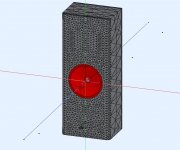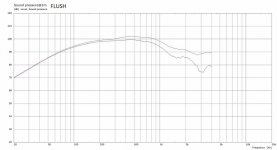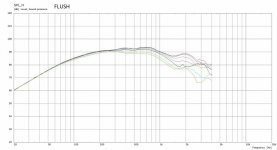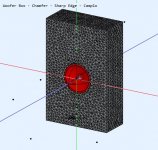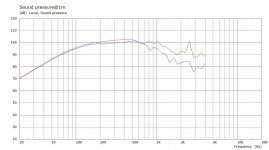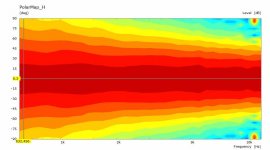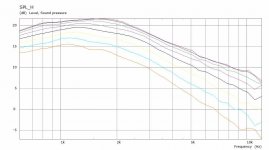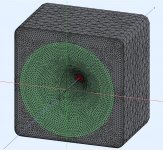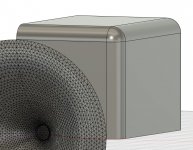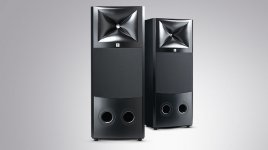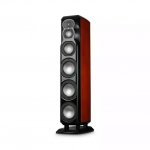"Try vituixCad diffraction sim, it takes only few minutes to find answers all questions you can ask..."
See? I'm STILL learning things!
See? I'm STILL learning things!
Prove that it happens at all frequencies. I'm dying to see the effect of edge diffraction at 300Hz.
Well, sound diffraction certainly exists (..cause that's the way diffraction works.)
..but the effect at lower freq.s may not be substantive for our purpose in *most instances. (..a typical sealed small subwoofer operated below 100 Hz is a good example where the effect of diffraction is not substantive.)
*one where it does have a substantive effect is a large horn/waveguide using the waveguide at or near average pressure down and below the horn's diameter vs. wavelength produced relative to that diameter.
Last edited:
Flaxxer,
Simulations are a great way to learn and experiment most acoustical principles behind loudspeakers design as well as their interaction with electronic (filters).
As well as retro engineering designs you heard, liked or disliked to see what is at play.
Strong educational potential.
Simulations are a great way to learn and experiment most acoustical principles behind loudspeakers design as well as their interaction with electronic (filters).
As well as retro engineering designs you heard, liked or disliked to see what is at play.
Strong educational potential.
*one where it does have a substantive effect is a large horn/waveguide using the waveguide at or near average pressure down and below the horn's diameter vs. wavelength produced relative to that diameter.
Then, if i understand what you say, and if we consider 15"/18" as big ( i don't remember exactly the size of the OS waveguide), it could explain why:
...for Summa... Iirc the xover is around 900hz so the waveguide should take care of most edge diffraction yet Earl included roundover which control down to this freq.
I think the Summa used a 12db/octave hp on the 1" which isn't very steepfilter for so low cutoff, so significant output below the horn diameter could be experienced. Maybe the round over could help there?
Anyhow, in the great scheme of things, what we think or call them is irrelevant as long we recognize the effects and know how to mitigate them 🙂
Sure.
I'll try if I can understand your point, maybe you'd give an example.
I said "in the range" suggesting above the baffle step. There is some contention as to what constitutes diffraction once you get into the driver's near-field.
I have no example, that's why i asked for proof. Didn't catch "in the range" aka above the baffle step. In my own deffence, i was multitasking 🙂
... Try vituixCad diffraction sim, it takes only few minutes to find answers all questions you can ask 🙂
I will try that, thanks. It never occured me to try it.
Well, sound diffraction certainly exists (..cause that's the way diffraction works.)
..but the effect at lower freq.s may not be substantive for our purpose in *most instances. (..a typical sealed small subwoofer operated below 100 Hz is a good example where the effect of diffraction is not substantive.)
*one where it does have a substantive effect is a large horn/waveguide using the waveguide at or near average pressure down and below the horn's diameter vs. wavelength produced relative to that diameter.
Yup, that would be the one case where it matters. Given how rare midbass horns are and even more rare to find any measurements (let alone high resolution measurements) of a system like that - it actually was bellow my radar. I guess that i think of systems like that like PA more than HiFi so i don't look at that direction.
Cheers
Flaxxer,
Simulations are a great way to learn and experiment most acoustical principles behind loudspeakers design as well as their interaction with electronic (filters).
As well as retro engineering designs you heard, liked or disliked to see what is at play.
Strong educational potential.
Thank you. This thread alone has taught me that. Replies like yours.
I am deep into learning the vituixCad diffraction sim online. But it will take a bit.
Can someone tell me what happens if you add large round corners on a large horn speaker, such as the Klipsch or Calampos with 15 + horn?
Say a 17.5" wide enclosure for our example. And the roundover corners say a full 4" ?
I'd prefer knowing what to expect, over the time it would take for me to sand pink foam into the corners and temporarily attach them. That is time intensive.
Can someone tell me what happens if you add large round corners on a large horn speaker, such as the Klipsch or Calampos with 15 + horn?
Say a 17.5" wide enclosure for our example. And the roundover corners say a full 4" ?
I'd prefer knowing what to expect, over the time it would take for me to sand pink foam into the corners and temporarily attach them. That is time intensive.
Putting large roundovers on any cabinet will reduce the effects of edge diffraction. This is still true when waveguides or horns are used but the effect is more subtle as less energy is sent to the edges due to the pattern control of the guide.
Building a chamfer or roundover right next to the horn mouth helps to reduce reflections that travel back down the horn from the mouth.
Earl Geddes speakers are a very good example of this where the waveguide blends in the baffle and roundovers to make the transition as smooth as possible.
Not everyone thinks that edge diffraction is an audible problem
AudioRoundTable.com: Pi Speakers >> Finish up a pair of 4pis
I'm not aware of any rigorous scientific double blind studies to help make the decision easier.
Building a chamfer or roundover right next to the horn mouth helps to reduce reflections that travel back down the horn from the mouth.
Earl Geddes speakers are a very good example of this where the waveguide blends in the baffle and roundovers to make the transition as smooth as possible.
Not everyone thinks that edge diffraction is an audible problem
AudioRoundTable.com: Pi Speakers >> Finish up a pair of 4pis
I'm not aware of any rigorous scientific double blind studies to help make the decision easier.
... and the directivity of the woofer used. This is one of the reasons, for me anyway, that make this particular topic such a rabbit hole.Putting large roundovers on any cabinet will reduce the effects of edge diffraction. This is still true when waveguides or horns are used but the effect is more subtle as less energy is sent to the edges due to the pattern control of the guide.
I'm a bit with Wayne Parham on the audibility aspect of diffraction as it relates to baffle width. For me, a wider baffle does seem to minimize the effect somewhat. As I tended to cross to a woofer a bit higher in frequency, the region of Fc seems unaffected by diffraction. ... but is that due to baffle width or driver dispersion?
In theory, the sharper corner(s) might only affect a small region of the woofers frequency response ... as it transitions from 4pi to 2pi radiation. North of that the woofers dispersion is off the baffle entirely.
Seems then that if a narrower baffle is desired, larger edge round overs become more necessary. Question then becomes if the smoother response in a small region is worth the effort round overs of that size entail? Just make the baffle wider and be done with it?
Yes some designer thinks it is a non issue.
One of the loudspeaker 'line' i was very impressed by didn't take this into account at all... from the designer mouth.
That said i would like to know more about the test M. Parham did: did they listened at constant volume? Did they tried at higher spl, lower,...?
I remember Earl Geddes explained the issue of cabinet diffraction is level related, the higher the level the more obvious the issue.
I've been bothered for long time by some artefacts i've heard into well known control room which use some very respected loudspeakers ( 70's designed Hidley's design ( pre 'non environnement') with kinoshita's RM4).
I stated many times in this board their was issue with this loudspeakers: they had a very level dependent width of the image ( the higher the level the more 'inflated' the stereo to me). Thoughts it was the horn, maybe the layout with juxtaposed 15", the compression drivers,...
Meanwhile i heard other models based on same horn and CD with different woofers lay out: sounded way better.
So i was sure it was the dual woofer...
Then i found this :
Tom Hidley - Non Environment Rooms – Acoustic Fields
and read the Stevie Wonder paragraph... and it strikes me, the loudspeakers wasn't at fault: what i heard was an issue about diffraction from the sofit mounting of loudspeakers in control room! Same thing as Stevie Wonder and what Earl Geddes explained ( effect varying with level).
It's not double blind test i agree. But still i heard this and identified it. And i wasn't alone ( thank you mister Wonder).
So i would not say it is a non issue. Better focus if you can hear the effect and if it is disturbing to you then make your own choice about this.
One of the loudspeaker 'line' i was very impressed by didn't take this into account at all... from the designer mouth.
That said i would like to know more about the test M. Parham did: did they listened at constant volume? Did they tried at higher spl, lower,...?
I remember Earl Geddes explained the issue of cabinet diffraction is level related, the higher the level the more obvious the issue.
I've been bothered for long time by some artefacts i've heard into well known control room which use some very respected loudspeakers ( 70's designed Hidley's design ( pre 'non environnement') with kinoshita's RM4).
I stated many times in this board their was issue with this loudspeakers: they had a very level dependent width of the image ( the higher the level the more 'inflated' the stereo to me). Thoughts it was the horn, maybe the layout with juxtaposed 15", the compression drivers,...
Meanwhile i heard other models based on same horn and CD with different woofers lay out: sounded way better.
So i was sure it was the dual woofer...
Then i found this :
Tom Hidley - Non Environment Rooms – Acoustic Fields
and read the Stevie Wonder paragraph... and it strikes me, the loudspeakers wasn't at fault: what i heard was an issue about diffraction from the sofit mounting of loudspeakers in control room! Same thing as Stevie Wonder and what Earl Geddes explained ( effect varying with level).
It's not double blind test i agree. But still i heard this and identified it. And i wasn't alone ( thank you mister Wonder).
So i would not say it is a non issue. Better focus if you can hear the effect and if it is disturbing to you then make your own choice about this.
Last edited:
A wide baffle does change things and the size of the woofer will affect the directivity too. So the crossover frequency will determine if edge diffraction on a woofer is in the passband or not. Below 500Hz there should be no real measurable difference between there and 1K the difference is not huge but can be seen. I've attached two simulations below of a 15" woofer the one marked flush is 500mm wide with a roundover and the other is 810mm wide with sharp edges.For me, a wider baffle does seem to minimize the effect somewhat. As I tended to cross to a woofer a bit higher in frequency, the region of Fc seems unaffected by diffraction. ... but is that due to baffle width or driver dispersion?
There is also the question as to whether the rest of the speaker already has other diffraction or similar issues which swamp out the effects of edge diffraction making it inaudible in that situation. Wayne's speakers use smaller horns higher in frequency and the termination on the horn, as is, will have an amount of diffraction and reflection.
I remember Earl Geddes explained the issue of cabinet diffraction is level related, the higher the level the more obvious the issue.
So i would not say it is a non issue. Better focus if you can hear the effect and if it is disturbing to you then make your own choice about this.
I tend to agree and was one of the reasons for me to try and build as low a diffraction speaker as I can to hear for myself what difference it might make.
Wayne said this further down the linked post
"The ones that tend to be most interested in edge diffraction - beyond the baffle step - those that are concerned with the more subtle effects tend to be the same designers that are interested in directivity and power response smoothness, e.g. uniformity of the reverberant field".
Smoothness of the off axis curves and power response is one of the most important factors in speakers rating highly in double blind testing from Floyd Toole and Harman. When you are aiming for that goal it seems silly to not worry about diffraction.
Attachments
Puppet, small or large baffle moves the same phenomenon up or down in frequency. All frequencies above the transition to 4pi radiation will diffract, roughly the frequencies that have smaller wavelength than the baffle.
But as you say the driver starts to beam at some point and doesnt radiate sound along the baffle and there is no diffraction problem frequensies above that. Now we have a bandwidth of wavelenghts that can diffract at the edge and those are roughly between the baffle size and transducer size. From this a simplified easy to remember rule of thumb is: minimize the flat baffle area around all transducers and diffraction is minimized. Be it narrow baffle without roundovers or wider with roundovers or slants.
Think a typical two way bookshelf speaker, rectangular baffle where a woofer fits. The woofer wont have any diffraction problems but the tweeter has loads of baffle around it and there is going to be diffraction on the tweeter passband, unless the baffle was slanted or what ever, waveguide. One could widen the baffle to fit huge roundovers, but there is going to be some diffraction interference still, but in lower frequency than with narrow baffle would have in similar scaled down situation. Tried to demonstrate this few pages back and on some other threads few months ago https://www.diyaudio.com/forums/multi-way/374497-im-building-4000-speaker-kit-57.html#post6744241
Huge roundovers have a bit less diffraction interference than minimal narrow baffle without, but are much harder to build.
But as you say the driver starts to beam at some point and doesnt radiate sound along the baffle and there is no diffraction problem frequensies above that. Now we have a bandwidth of wavelenghts that can diffract at the edge and those are roughly between the baffle size and transducer size. From this a simplified easy to remember rule of thumb is: minimize the flat baffle area around all transducers and diffraction is minimized. Be it narrow baffle without roundovers or wider with roundovers or slants.
Think a typical two way bookshelf speaker, rectangular baffle where a woofer fits. The woofer wont have any diffraction problems but the tweeter has loads of baffle around it and there is going to be diffraction on the tweeter passband, unless the baffle was slanted or what ever, waveguide. One could widen the baffle to fit huge roundovers, but there is going to be some diffraction interference still, but in lower frequency than with narrow baffle would have in similar scaled down situation. Tried to demonstrate this few pages back and on some other threads few months ago https://www.diyaudio.com/forums/multi-way/374497-im-building-4000-speaker-kit-57.html#post6744241
Huge roundovers have a bit less diffraction interference than minimal narrow baffle without, but are much harder to build.
Last edited:
The lowest diffraction result I can get in simulation from a baffled waveguide comes from having as smooth a mouth transition to the most minimal baffle straight into a roundover on all edges.
Attachments
Fluid, and it makes sense, that is the right way to do it if waveguide is on a baffle. Very good results. The freestanding waveguides with roundovers perform a bit better still but there are reasons to include waveguide into a baffle. Many of you already know all this, but there are plenty who havent thought about it yet 🙂
Last edited:
One more, check out the classic diyaudio references JBL M2 and Revel Salon 2, they both have minimized flat baffle area, very good measured response and listening impressions.
Attachments
Last edited:
Yes but a freestanding waveguide is not necessarily going to have the aesthetic approval rating as an integrated one, regardless of the merits, which for a DIYer are worth considering.
That might be the biggest reason to integrate waveguide into the baffle. Some other good reasons are free extra volume for the woofer enclosure and double duty as a night/flower stand 🙂 Also roundovers seem to be tougher to the eye than square edges, but all have their own aesthetics. Luckily there are some options to choose between and still have very good performance.
Last edited:
There are two ways a freestanding guide could be considered better, one is immunity from other drivers or cabinet (apart from a large flat surface behind) changing the response of the waveguide and the ability to make them smaller for similar directivity.Very good results. The freestanding waveguides with roundovers perform a bit better still but there are reasons to include waveguide into a baffle.
The waveguide in a baffle straight to a roundover is pretty much on par in terms of smoothness of directivity and diffraction reduction particularly if it is all designed to work together. The potential benefit of the baffle is the extension of directivity to a lower frequency.
Both can be made to perform to an extremely high level, either capable of meeting or passing most commercially available options right now.
I could refer to KEF 105 and B&W 801, I suppose 😉One more, check out the classic diyaudio references JBL M2 and Revel Salon 2, they both have minimized flat baffle area, very good measured response and listening impressions.
In most cases where I added a large round-over / chamfer to a baffle I could hear an improvement (less colouration)
You can try it on your existing speakers; cut a 25-50mm wide cardboard strip and attach to the edges of the cabinet with 45 degree angle with bit of tape to hold it on.
You can try it on your existing speakers; cut a 25-50mm wide cardboard strip and attach to the edges of the cabinet with 45 degree angle with bit of tape to hold it on.
Last edited:
- Home
- Loudspeakers
- Multi-Way
- I'm building a $4000 speaker kit ... Which one?
